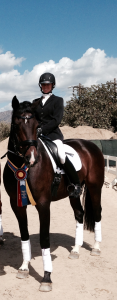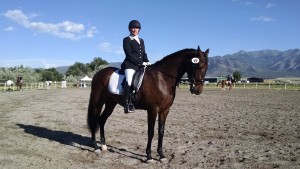ST. GEORGE – It’s a sport born from the art of war. Dressage, the competitive equestrian event, has its roots in cavalry training. The method was first used and documented by the ancient Greeks. Modern dressage continues the classical art of training the horse and rider to act as one.
“Originally, the horses were taught the maneuvers so that they could appear more compelling in battle,” said Stacy Williams, dressage trainer and instructor. “Then later, as there became more leisure time, the royal families had fleets of horses and training with professional trainers who would develop these beautiful horses who were essentially push-button creatures that the king could sit on, or the prince could sit on, and look amazing and not really know how to ride very well.”
It may be a push-button ride for royals but dressage is a long-term commitment for both the human and equine competitor. Years may pass as the team perfects the multiple difficult maneuvers required for competition.
Professional rider Williams and Adult Amateur rider Linda Thompson will be putting their skills on display at the U.S. Dressage Federation regional finals competition in Scottsdale, Arizona, Oct. 16-18. Both women have been pursuing perfection in dressage for more than a decade.
“In dressage, it’s the one sport where age helps because you need experience,” Williams said. “You get better and better at controlling your body.”
The same is true of the equine athletes.
“It takes quite a bit of time to get the horse physically strong enough to do the work you’re asking of them. You think in terms of the strength that a weight lifter has to have in addition to the finesse and balance and agility that a ballerina has to have and combine that into one athlete,” Williams said. “That is what a dressage horse has to do. They have to be very powerful and expressive while being very supple and brilliant and beautiful at the same time and it has to look effortless.”

Williams is the only U.S. Dressage Federation accredited instructor and trainer in the state. She has competed at the highest levels in the sport and now leads a small band of dedicated dressage riders based out of Lava Bluffs Equestrian Center in St. George. She and her horse, Frisco Bay a seven-year-old Westfalen gelding, have qualified to compete in the Open Second Level and Second Level Freestyle divisions in Scottsdale.
For the uninitiated, dressage competition in the United States is divided into five levels from Training level through Fourth level. Once teams have achieved success in those brackets, international competition begins with the Prix St. Georges, through two more levels ending at the highest bracket of competition, the Grand Prix. Olympic dressage competition occurs at this highest level.
Explaining the highly nuanced tests horse and rider must pass is difficult. At the highest level of the sport, a dressage horse and rider must exhibit specialized skills including an elevated trot in place (Piaffe), a 360 degree turn in place (Pirouette) and a variety of extended and collected gaits.
“When they first start out they aren’t expected to look quite so flamboyant in their gaits. That’s something you develop with strength and training,” Williams said. “Unless you have a freakishly talented horse, you don’t just go around the ring with the flamboyant gaits you see in the Olympics. You have to develop that over time. It can take, depending on the experience of the rider and the talent of the horse, anywhere from five years to 12 years to get a horse to Grand Prix.”
Competition isn’t what drew Linda Thompson to the sport. It was the dynamic between horse and rider.
“It’s very classical and I was in the ballet so I’m drawn to the classical stuff,” she said. “When the partnership melds it’s like a dance partner.”

Thompson will be riding her seven-year-old Andalusian gelding, Cazador RHR, in Scottsdale. Cazador is Thompson’s third equine dressage partner. This will be her second time at regionals but a first for her current mount. Thompson said she uses competition to mark progress in her training. Prestige and ribbons are secondary to progress.
“For me that’s not what it’s about. It’s about how we’re progressing in our riding and our relationship,” Thompson said. “If we get a blue ribbon, that’s cool. If we didn’t but our score was good, that’s really good.”
Thompson looks forward to the judges comments on the performance which she’ll use for training guidance. The competition is important but not her ultimate goal.
“It’s not my life. It’s great to win and it’s great to move on,” she said.
Thompson said she loves the hard work of the sport, and the special relationship she has with her horses.
“You can tell them your secrets and they don’t tell anybody,” she said.
The United States Dressage Federation Region 5 Championships will be held Oct. 16-18 in Scottsdale, Arizona. Successful competitors will move on to the 2015 USDF Finals Nov. 5-8 in Lexington, Kentucky.
Resources
Email: [email protected]
Twitter: @STGnews
Copyright St. George News, SaintGeorgeUtah.com LLC, 2015, all rights reserved.